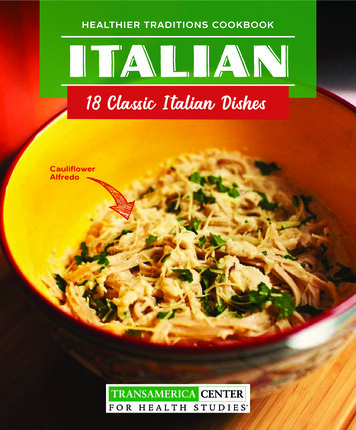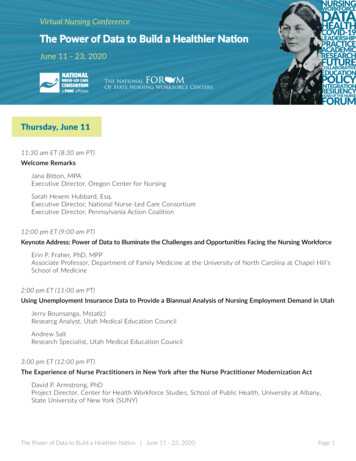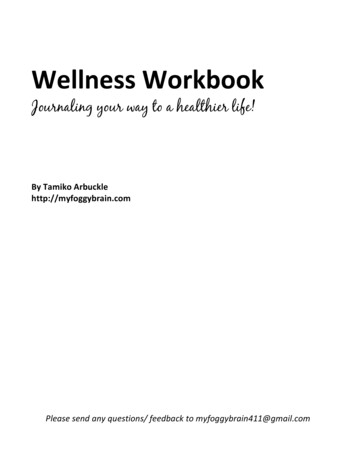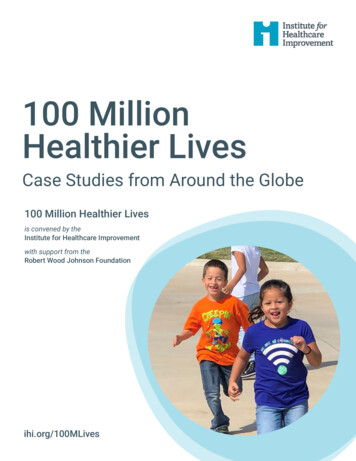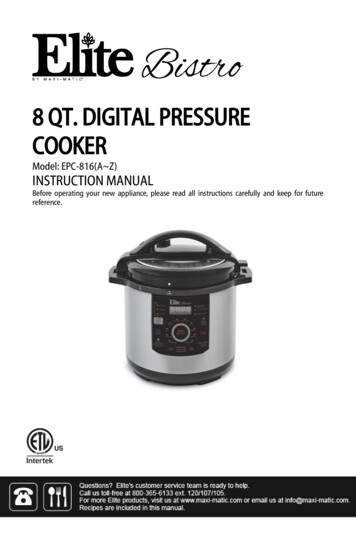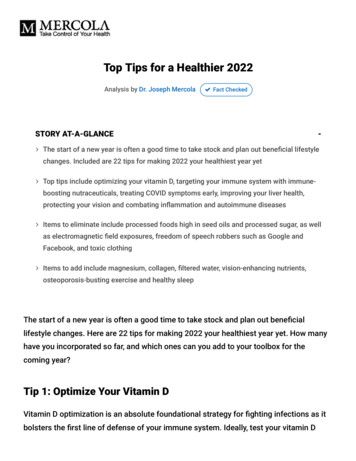
Transcription
Top Tips for a Healthier 2022Analysis by Dr. Joseph Mercola Fact CheckedSTORY AT-A-GLANCE- The start of a new year is often a good time to take stock and plan out beneficial lifestylechanges. Included are 22 tips for making 2022 your healthiest year yet Top tips include optimizing your vitamin D, targeting your immune system with immuneboosting nutraceuticals, treating COVID symptoms early, improving your liver health,protecting your vision and combating inflammation and autoimmune diseases Items to eliminate include processed foods high in seed oils and processed sugar, as wellas electromagnetic field exposures, freedom of speech robbers such as Google andFacebook, and toxic clothing Items to add include magnesium, collagen, filtered water, vision-enhancing nutrients,osteoporosis-busting exercise and healthy sleepThe start of a new year is often a good time to take stock and plan out beneficiallifestyle changes. Here are 22 tips for making 2022 your healthiest year yet. How manyhave you incorporated so far, and which ones can you add to your toolbox for thecoming year?Tip 1: Optimize Your Vitamin DVitamin D optimization is an absolute foundational strategy for fighting infections as itbolsters the first line of defense of your immune system. Ideally, test your vitamin D
level twice a year, in the winter and summer, to make sure you're in a healthy range of 60ng/mL to 80 ng/mL year-round. (A compelling body of research suggests 40 ng/mL isthe cutoff for sufficiency.)Vitamin D can reduce your risk of COVID-19 and other respiratory infections by reducingthe survival and replication of viruses, reducing inflammatory cytokine production,maintaining endothelial integrity and increasing ACE2 concentrations, which helps lowerCOVID-19 severity.If your vitamin D levels are not optimal and you come down with COVID, it is best to take0.5 mcg of calcitriol on the first day and then 0.25 mcg for a week, as this is the activeform of vitamin D. Merely swallowing regular vitamin D capsules will not help withCOVID for one to two weeks, which is why you must add calcitriol.You can learn more about the mechanisms behind vitamin D in my June 2020 scientificreport, available on StopCovidCold.com. October 31, 2020, I also published a scientificreview1 in the peer-reviewed journal Nutrients — "Evidence Regarding Vitamin D and Riskof COVID-19 and Its Severity" — co-written with William Grant, Ph.D., and Dr. CarolWagner, both of whom are part of the GrassrootsHealth expert vitamin D panel. You canread the paper for free here.Tip 2: Up Your Intake of Key Immune-Boosting NutrientsMany nutrients are known for their immune-boosting properties and ability to wardagainst encapsulated RNA viruses such as influenza and coronaviruses. A number ofthem were identified and listed in a February 2020 article in the journal Progress inCardiovascular Diseases.2,3,4A number of nutrients have also shown promise against the atypical symptomsassociated with severe COVID-19, such as excessive, out of control inflammation andblood clots.While these symptoms have become increasingly rare as the virus has mutated intomilder strains (Omicron being a prime example), some early COVID-19 patients are still
struggling with long-term symptoms, colloquially known as "long COVID." For them, suchnutraceuticals may be particularly helpful.Here's a summary of the nutritional supplements identified. (For suggested dosages,see the Progress in Cardiovascular Diseases paper.5)N-acetylcysteine (NAC) — Encourages glutathione production, thins mucus, lowersyour chances of influenza infection and reduces your risk of developing severebronchitis.Elderberry extract — Known to shorten influenza duration by two to four days andreduce the severity of the flu.Spirulina — Reduces severity of influenza infection severity and lowers influenzamortality in animal studies. In a human trial, spirulina significantly lowered the viralload in patients with HIV infection.Beta-glucan — Reduces severity of influenza infection severity and lowers influenzamortality in animal studies.Glucosamine — Upregulates mitochondrial antiviral-signaling protein (MAVS),reduces severity of influenza infection severity and lowers influenza mortality inanimal studies.Selenium — Selenium deficiency increases the rate at which viruses can mutate,promoting the evolution of more pathogenic strains.Zinc — Supports "effective function and proliferation of various immune cells,"lowering mortality in the elderly by 27%. If treating acute COVID, it's best taken withquercetin (500 mg) to drive the zinc into the cell to limit viral replication.Lipoic acid — Helps boost type 1 interferon response, which activate intracellularantimicrobial programs, thereby limiting viral spread between cells, and modulate
your innate immune responses, restraining pro-inflammatory pathways and inhibitingcytokine production. They also activate your adaptive immune system.6Sulforaphane — Helps boost type 1 interferon response.Resveratrol — A 2005 study7 in The Journal of Infectious Diseases found resveratrolhas the power to inhibit the replication of influenza A virus, significantly improvingsurvival in influenza-infected mice. According to the authors, resveratrol "acts byinhibiting a cellular, rather than a viral, function," which suggests it "could be aparticularly valuable anti-influenza drug."Tip 3: Treat COVID as FIRST Sign of InfectionShould you develop COVID symptoms, you simply MUST start treatment immediately.We now know early treatment is key for successful resolution of the infection. It couldliterally be the difference between life and death and I can't stress that enough. It is farbetter to overtreat a cold like COVID than ignoring the symptoms and dismissing them.There are several early treatment protocols available, most of which focus on similarremedies. I believe the Frontline COVID-19 Critical Care Alliance's (FLCCCs) protocol isamong the most comprehensive. You can find a listing of doctors who can prescribenecessary medicines on the FLCCC website.There, you can also find downloadable PDFs in several languages for prevention andearly at-home treatment, the in-hospital protocol and long-term management guidancefor long-haul COVID-19 syndrome.A slightly revised version of the FLCCC protocol is below. I've altered some of thedosages, and added a few more therapies that they have yet to include, such asnebulized hydrogen peroxide and intravenous ozone.
Tip 4: Optimize Your Health With Systemic EnzymesEnzymes are proteins composed of individual amino acids necessary to speed upcellular functions and biological processes. Some of the bodily processes that requireenzymes include energy production, oxygen absorption, toxic waste removal, breakingdown fats in your blood, dissolving blood clots and fighting infections.“Proteolytic enzymes such as lumbrokinase andserrapeptase act as blood cleansers that combatinflammation and rebalance your immune system.”In the era of COVID, an enzyme called lumbrokinase may be of particular benefit, as ithelps break down blood clots. If you've had COVID-19 in the past, and/or received one or
more COVID injections, lumbrokinase may be helpful to prevent blood clotting issues.Proteolytic enzymes such as lumbrokinase and serrapeptase serve to digest unwantedproteins in your blood, like blood clots. They also help combat inflammation andrebalance your immune system, facilitating the removal of inflammatory proteins,removing fibrin (a clotting material that restricts blood flow and prolongs inflammation),reducing edema in inflamed regions, and boosting the potency of macrophages andkiller cells.If you want these enzymes to work on the potentially damaging proteins in your bloodand not the food in your stomach, you will need to take them on an empty stomach,either one hour before or two hours after a meal. Otherwise the enzymes will be used todigest your food and not work in your bloodstream.Tip 5: Boost Your Liver Health With CholineNonalcoholic fatty liver disease (NAFLD) is a common condition caused by an unhealthyprocessed food diet. Aside from cutting out processed foods high in sugars and seedoils, adding in more choline can be helpful, as it appears to be a key controlling factor inarresting the development of fatty liver.It does this by enhancing secretion of very low density lipoprotein (VLDL) particles inyour liver, which are required to safely transport fat out of your liver. Choline deficiencymay result in excess fat and cholesterol buildup. Choline also aids in DNA synthesis andis important for healthy mitochondrial function.Choline-rich foods to consider loading up on include wild-caught Alaskan salmon, krilloil, organic pastured chicken, vegetables such as broccoli, cauliflower and asparagus,shiitake mushrooms, grass fed beef liver and pastured egg yolks.A single hard-boiled egg can contain anywhere from 113 to 147 milligrams of choline, orabout 25% of your daily requirement, making it one of the best choline sources in theAmerican diet. Only grass fed beef liver beats it, with 430 milligrams of choline per 100gram serving.
Tip 6: Eliminate ALL Seed (Vegetable) OilsA compelling report in the journal Gastroenterology offers a radically novel yet logicallysound explanation as to why some COVID-19 patients develop life-threatening organfailure, namely their high unsaturated fat intake. Since diet-related comorbidities areresponsible for 94% of COVID-19-related deaths,8 taking control of your diet is a simple,common-sense strategy to lower the risks associated with this infection.Simply put, high intake of polyunsaturated fats (PUFAs) — a primary source of which isindustrial seed oils — is associated with increased mortality from COVID-19, whilehealthy saturated fats actually lower your risk of death.Omega-6 linoleic acid (LA) makes up the bulk of the omega-6 consumed and is theprimary contributor to nearly all chronic diseases, because when consumed in excessiveamounts, LA acts as a metabolic poison radically limiting mitochondrial function andyour ability to produce cellular energy.The reason for this is because polyunsaturated fats such as LA are highly susceptible tooxidation. As the fat oxidizes, it breaks down into harmful sub-components such asadvanced lipid oxidation end products (ALES) and oxidized LA metabolites (OXLAMs).These ALES and OXLAMs are actually what cause the damage.While excess sugar is certainly bad for your health and should typically be limited to 25grams per day or less, it doesn't cause a fraction of the oxidative damage that LA does.Processed vegetable oils are a primary source of LA, but even food sources hailed fortheir health benefits contain it, and can be a problem if consumed in excess. Cases inpoint: olive oil and conventionally raised chicken, which are fed LA-rich grains.Tip 7: Boost Your Magnesium IntakeMagnesium is required for the healthy function of most cells in your body. Deficiencywill impede your cellular metabolic function and deteriorate mitochondrial function,which can result in more serious health problems. Deficiency is widespread, thanks to
inadequate consumption of leafy greens, so if you rarely eat your veggies, you couldprobably benefit from supplementation.Having low amounts of magnesium has also been shown to significantly increase yoursupplemental vitamin D requirement. Research by GrassrootsHealth9 shows you need146% more vitamin D to achieve a blood level of 40 ng/ml (100 nmol/L) if you do nottake supplemental magnesium, compared to taking your vitamin D with at least 400 mgof magnesium per day.Your vitamin K2 intake can also affect your required vitamin D dosage. Data10 fromnearly 3,000 individuals revealed 244% more oral vitamin D was required to get 50% ofthe population to achieve a vitamin D level of 40 ng/ml (100 nmol/L) if they weren'tconcurrently also taking magnesium and vitamin K2. So, a simple way to optimize yourvitamin D absorption is to take it in conjunction with magnesium and K2.Foods with the highest magnesium levels include spinach, Swiss chard, turnip greens,beet greens, collard greens, broccoli, Brussels sprouts, kale, bok choy and romainelettuce.If you're using a supplement, you may want to use magnesium threonate to provide atleast some of your magnesium, as it appears to be most efficient at penetrating cellmembranes, including your mitochondria and blood-brain barrier. Another effective wayto boost your magnesium level is to take Epsom salt (magnesium sulfate) baths, as themagnesium will effectively absorb through your skin.Tip 8: Improve Your Bowel EvacuationHealthy evacuation of your bowels is a factor that many tend to ignore. The good newsis that improving your bowel function can be as simple as changing how you sit on thetoilet. Your puborectalis muscle helps control elimination during a bowel movement andprevent incontinence when you're standing.However, when you sit on a typical toilet, this muscle cannot fully relax, which is why youmay need to push or even strain in order to have a bowel movement. While squatting,
however, the muscle relaxes fully, making elimination easier.Squatting on the toilet bowl can help you eliminate waste better if you are constipated.But this requires strength, flexibility and balance, especially if you're not used to thismethod. Other options include using a simple footstool to help you get into a more"squatty" position or leaning forward as you sit on the toilet, with your hands on or nearthe floor.Tip 9: Combat Chronic InflammationChronic inflammation is a hallmark of virtually all disease, including cancer, obesity andheart disease. While inflammation is a perfectly normal and beneficial process thatoccurs when your body's white blood cells and chemicals protect you from foreigninvaders like bacteria and viruses, it leads to trouble when the inflammatory responsegets out of hand and continues indefinitely.Your diet plays a significant, if not primary, role in this chain of events and is the perfectplace to start to address it. Certain nutritional supplements can also be helpful as addons. Here's a summary of key principles: Limit or eliminate vegetable oils (seed oils) — A key part of an anti-inflammatorydiet involves excluding refined vegetable oils, as they are clearly one of the mostpernicious and pervasive poisons in the food supply. Simply avoiding all processedfoods and most restaurant foods will go a long way toward helping you avoid them. Eat more veggies — Vegetables are a key anti-inflammatory staple. Ideally, opt fororganic locally grown veggies that are in season, and consider eating a fair amountof them raw. If you struggle with autoimmune disease or have significantinflammation in your body, though, consider limiting vegetables with high lectincontent. Some high- lectin foods can be made safer to eat through proper soakingand cooking, as well as fermenting and sprouting. Add in fermented foods — Traditionally fermented and cultured foods are other antiinflammatory staples that work their "magic" by optimizing your gut flora. A majority
of inflammatory diseases start in your gut as the result of an imbalancedmicrobiome.Fermented foods such as kefir, natto, kimchi, miso, tempeh, pickles, sauerkraut,olives and other fermented vegetables will help reseed your gut with beneficialbacteria. Ideally, you'll want to eat a wide variety of them as each contains adifferent set of beneficial bacteria (probiotics).If you don't like fermented vegetables, consider yogurt made from raw, organic milkfrom grass fed cows. Yogurt has been shown to reduce inflammation by improvingthe integrity of your intestinal lining, thereby preventing toxins in your gut fromcrossing into your bloodstream. Boost your omega-3 fat intake — Marine-based omega-3 fats found in fatty coldwater fish that are low in environmental toxins — such as wild Alaskan salmon,sardines and anchovies — are also important anti-inflammatories, particularly forbrain and heart health. In fact, your omega-3 level is a powerful predictor ofmortality. If you don't enjoy these types of fish, consider using krill oil instead. Cook with herbs and spices — Ounce for ounce, herbs and spices are among themost potent anti-inflammatory ingredients available and making sure you're eatinga wide variety of them on a regular basis can go a long way toward preventingchronic illness. Among the most potent anti-inflammatory herbs and spices arecloves, cinnamon, Jamaican allspice, apple pie and pumpkin pie spice mixtures,oregano, marjoram, sage, thyme and Italian spice.Tip 10: Filter Your WaterWhile the U.S. has many water quality concerns, it doesn't really matter where you liveanymore, as many dangerous chemicals find their way into the ecosystem, spreadingfrom one continent to another. This is why filtering your household water is more anecessity than an option these days.
Filtering your drinking water is good practice, but equally important is filtering the wateryou use for bathing. This is because immersing yourself in contaminated water may beeven more hazardous to your health than drinking it.Chemicals absorbed through your skin go directly into your bloodstream, bypassing yourdigestive and internal filtration systems. Unfiltered water can also expose you todangerous chlorine vapors and chloroform gas, which can cause dizziness, fatigue,asthma, airway inflammation and respiratory allergies.Unless you can verify the purity of your water, you should seriously consider installing ahigh-quality, whole-house water filtration system. Ideally, filter the water both at thepoint of entry and at the point of use. This means filtering all the water that comes intothe house, and then filtering again at the kitchen sink and shower. As for the type offiltration system to get, there are various options, most of which have both benefits anddrawbacks.Common options include reverse osmosis (RO), ion exchange, and granular carbon orcarbon block filters. Ideally, you want a filtration system that uses a combination ofmethods to remove contaminants, as this will ensure the removal of the widest varietyof contaminants.Tip 11: Reduce Your EMF ExposureOne of the most dangerous kinds of pollution affecting your health is the invisible sea ofelectromagnetic fields (EMFs) your body swims in daily, both outdoors and in yourhome. Common sources include cell phones, cell towers, computers, smart meters andWi-Fi, to name just a few. Strategies to reduce your EMF exposure include:Connect your computer to the internet via a wired connection and put it in airplanemode. Also opt for wired keyboards, trackballs, mice, printers and house phones.If you must use Wi-Fi, be sure to shut it off whenever it's not in use, especially atnight.
Shut off the electricity to your bedroom at night to reduce electrical fields from thewires in your walls.Use a battery-powered alarm clock, ideally one without any light.Replace your microwave oven with a steam convection oven, which will heat yourfood quickly and far more safely.Avoid "smart" appliances and thermostats that depend on wireless signaling,including smart TVs. Consider using a large computer monitor as your TV instead,as it doesn't emit Wi-Fi.Opt out of smart meters if you can or add a shield to an existing smart meter.Avoid using a wireless baby monitor. Instead, move the baby's bed into yourbedroom, or use a hard-wired monitor.Remove all fluorescent lights from your home and switch to incandescent bulbs.Avoid carrying your cell phone on your body unless it's in airplane mode, and neversleep with it in your bedroom.Use the speakerphone on your cell phone, and hold it at least 3 feet away from you.Ideally, use your cell phone as little as possible.Even if you implement these strategies, you're unlikely to eliminate all exposure, asEMFs saturate public places and can invade your home from your neighbors. Tominimize the harmful effects, the following strategies can be helpful: Increase your magnesium intake — As a natural calcium channel blocker,magnesium can help reduce the effects of EMF on your voltage-gated calciumchannels. Since many are deficient in magnesium, I believe you could benefit fromas much as 1 to 2 grams of magnesium per day.
Molecular hydrogen — Molecular hydrogen has been shown to target free radicalsproduced in response to radiation, such as peroxynitrites. Studies have shownmolecular hydrogen can mitigate about 80% of this damage.Molecular hydrogen will also activate Nrf2, a biological hormetic that upregulatessuperoxide dismutase, catalase and all the other beneficial intercellularantioxidants. This in turn lowers inflammation, improves your mitochondrialfunction and stimulates mitochondrial biogenesis. Protective spices — Cinnamon, cloves, ginger root, rosemary and turmeric haveexhibited protective effects against EMF-induced damage.Tip 12: Boost Your Collagen Production NaturallyCollagen is the most common and abundant of your body's proteins. One of its primarypurposes is to provide structural scaffolding for your various tissues to allow them tostretch while still maintaining tissue integrity.As a compound of essential amino acids, there's only one way to get collagen: Yourbody can't produce it, so you must obtain it through your diet. Historically, traditionaldiets provided ample collagen in the form of broth made from boiled chicken feet orbeef bones. These are by far your best alternatives.If you decide to use a collagen supplement, it's important to know what to look for.Laboratory testing has revealed many popular collagen and bone broth products containpotentially hazardous contaminants typically associated with concentrated animalfeeding operations (CAFOs), so to avoid contaminants, make sure your collagensupplement is certified "100% Organic" by the U.S. Department of Agriculture (USDA).Moreover, collagen supplements can be either unhydrolyzed (undenatured) orhydrolyzed (denatured). The processing that most collagen supplements undergo tobecome hydrolyzed can also result in questionable byproducts that are best avoided. Mypersonal preference is to use a less denatured (unhydrolyzed) organic collagensupplement, as it has a more balanced amino acid profile.
That said, I still believe the natural approach is best. Making homemade bone brothusing bones and connective tissue from grass fed, organically raised animals isn't verycomplicated and will produce the best results.Tip 13: Optimize Your SleepOne of the most radical and recent discoveries revealing the importance of sleep forhealth is that each and every organ has its own biological clock. In your brain is a"master clock" that synchronizes these clocks and your bodily functions to match the24-hour light and dark cycle.When you upset your circadian rhythm by not getting enough sleep, the results can havefar-reaching consequences, affecting everything from mood, creativity and braindetoxification to DNA expression, chronic disease risk — including dementia — andlongevity. Helpful tips to optimize your sleep include:Sleep in complete darkness, or as close to it as possible, to avoid lowering melatoninproduction, which can interfere with your sleep.Keep the temperature in your bedroom no higher than 70 degrees Fahrenheit.Eliminate EMFs in your bedroom.Keep all electronic devices at least 3 feet from your bed.Adopt a neutral sleeping position by propping your pillow under your neck, not yourhead, to maintain a proper spinal curve.Reserve your bed for sleeping and don't keep a TV in your bedroom.Consider separate bedrooms if sharing your bed with a partner impairs your sleep.Pets may also need to be kept in another room if they disturb your sleep.
Tip 14: Ditch Google and Facebook Once and for AllOver the years, the government and business monopolies, including the likes of BigTech, have formed a global alliance hell-bent on protecting and concentrating memberprofits. The price for keeping business going as usual is personal liberty and freedom ofspeech that may impact these fascist government-industrial complexes.In recent times, we've seen unprecedented efforts to censor natural health topics invarious online platforms, especially Google and Facebook, under the guise of protectingyou against "misinformation."By censoring the voices that challenge mainstream information on crucial health topicslike pharmaceutical drugs, vaccines, GMOs, pesticides, junk foods, artificial sweetenersand fake meat, Google and Facebook are able to protect the profits of its advertisersand stakeholders.Across the board, Google only gives you the results they want you to see, while relevantarticles and news they deem "harmful" are buried. Facebook, meanwhile, relies on socalled "fact checkers" to dissuade and redirect users away from anything thatcontradicts the mainstream narrative. We now have proof that Facebook's "fact checks"are nothing more than opinion pieces, thanks to a lawsuit by journalist JohnStossel,11,12,13 but they're still presented as assertions of facts.If you're fed up with Google's and Facebook's exploitation and manipulation, the bestway to break free is by being informed. If we work together to boycott them, Google andFacebook will crumble.We have added a built-in sharing tool on top of each newsletter article to make it easierfor you to share it to your friends and family via email or text. And, while the articles onmy website are only viewable for 48 hours, we are in the process of transferring ourentire archive over to the Censored Library on Substack. This will allow us to bring backmy previously deleted articles in a liability-protected format.
For just 5 a month, or the discounted annual rate of 50 per year, you will have accessto all of my articles, all the time, even after they've been deleted from Mercola.com.Tip 15: Protect Your Eye HealthYour ocular health affects your overall well-being, so routine eye exams are an importanthealth basic. Additionally, keep your eyes healthy and your vision sharp by: Removing trans fats from your diet — As with linoleic acid, processed foods andbaked goods are primary sources of harmful trans fats. Removing high fructose corn syrup from your diet — High blood pressure candamage the small blood vessels in your retina, obstructing blood flow, and a keystrategy to normalize your blood pressure is to dramatically reduce your fructoseintake.
High sugar intake is also a primary culprit of elevated blood sugar readings. Highblood sugar not only obstructs blood flow by damaging blood vessels in your retinabut also pulls fluid from the lens of your eye, which can affect your ability to focus.As a general guide, I recommend keeping your total daily fructose consumptionbelow 25 grams a day, including fructose from fruit. Eating your veggies — Consuming high amounts of carotenoid-rich vegetables,especially ones rich in lutein and zeaxanthin, can encourage healthy vision. Boosting your omega-3 fat intake — Omega-3 fats protect healthy vision. Goodsources include wild-caught Alaskan salmon, sardines and anchovies. If you use asupplement, I recommend krill oil, which also contains astaxanthin, a potentantioxidant. Quitting smoking — Smoking increases free radical production throughout yourbody, putting you at risk for any number of health problems, including visionproblems.Aside from lutein and zeaxanthin, astaxanthin is one of the best antioxidants for eyehealth. It's been shown to protect against a number of eye-related problems, includingage-related macular degeneration, which is the No. 1 cause of blindness in the elderly,glaucoma, cataracts, inflammatory eye diseases, cystoid macular edema, retinal arterialocclusion, diabetic retinopathy and venous occlusion.Astaxanthin also helps maintain appropriate eye pressure, energy levels and visualacuity. Because the above list includes several of the leading causes of blindness in theU.S., this powerful antioxidant becomes increasingly important.Tip 16: Grow Your Own FoodGrowing your own food has many rewards, from providing you with fresher,uncontaminated produce and cutting your grocery bill, to increasing your sense of wellbeing and slashing your risk of depression. Research14 also shows elderly individualswho garden on a regular basis have a 36% lower risk of dementia than non-gardeners.
There are many different ways to grow your own food, even if you live in an apartment.You can use virtually every square foot of your space, including vertical space, forgrowing food. Hanging baskets are ideal for a wide variety of foods, such asstrawberries, leafy greens, runner beans, pea shoots, tomatoes and a variety of herbs.And, instead of flowers, window boxes can hold herbs, greens, radishes, scallions, bushbeans, strawberries, chard and chilies, to name just a few.Rule No. 1 for growing nutrient-dense food is building healthy soil. There are five basicprinciples to growing topsoil and building a healthy soil ecosystem, and these rulesapply whether you're working a farm or tending a small vegetable garden in yourbackyard:1. Avoid disturbing the soil microbiome — The less mechanical disturbance the better,which means no tillage, herbicides, pesticides or fungicides2. Protect the soil's surface — Use cover crops, untreated lawn clippings, mulch andwood chips to maintain soil biology, prevent water evaporation and lower soiltemperature, which is particularly important on hot days3. Diversify your crops — Having a diverse array of plant life is essential to healthysoil, and cover crops help fulfill this requirement4. Maintain living roots in the ground as long as possible — Growing something at alltimes is key to soil vitality, so be sure to plant a cover crop after you harvest yourvegetables5. Integrate livestock and other animals, including insects — To mimic the impact ofwild herds, regenerative farmers will pasture chickens, cows, lambs, pigs and otheranimals to benefit the soil
The star t of a new year is often a good time to take stock and plan out benecial lifestyle changes. Included are 22 tips for making 2022 y our healthiest year yet Top tips include optimizing y our vitamin D, targeting your immune system with immune-boosting nutraceuticals, tr





